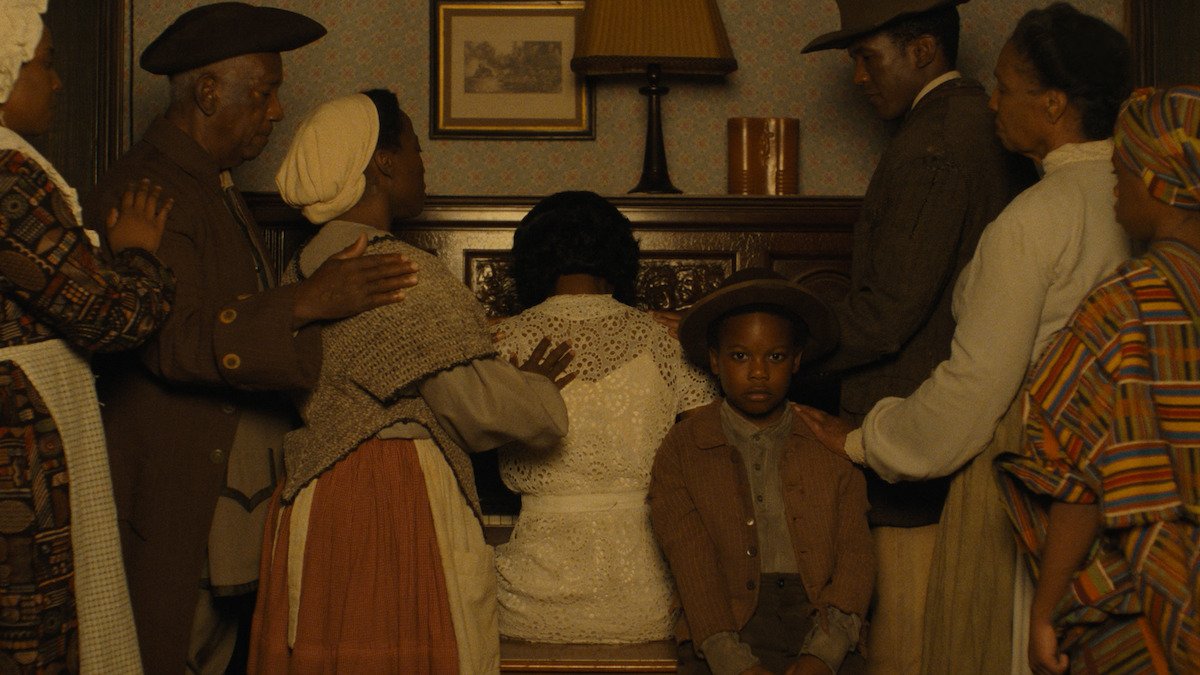Y2K
Directing: C+
Acting: B-
Writing: C-
Cinematography: B
Editing: C+
Y2K is really fun, for about twenty minutes. The opening scene is super fun, very deliberately tugging at our weird nostalgia for AOL Instant Messenger or the sound of dial-up modems. The first thing we see is computer screen activity, multiple AIM chat windows open at once, as well as a window showing a video clip of President Clinton (or, as a character later calls him, “President Blowjob”) commenting on the spectre of the Y2K bug.
Our introduction to Eli (Jaeden Martell) and his best friend Danny (Julian Dennison) is fun, especially as they chat in Eli’s bedroom while they wait for a topless photo of a woman to load in horizontal sections on his computer screen. Of course, the gag is a bit undermined by all the action going on with his computer screen in the opening shots, without any glitches whatsoever.
Still, Eli and Danny are perfectly endearing characters. We briefly see Eli’s parents, who talk a little awkwardly about Eli finding someone to kiss at the stroke of midnight. It’s New Year’s Eve 1999, you see. When Eli’s mom kisses him on the cheek, he makes a face perfect for setting the tone of a modern teen comedy.
Danny is preoccupied with one of them getting laid. Eli pines for a popular girl, Laura (Rachel Zegler). Pretty standard teen comedy stuff, most of it relatively charming, none of it particularly clever. Booksmart, this is not. Eli and Danny hang out for a few hours before deciding to go to a New Year’s Eve party. It takes just slightly too long for this movie to get to the critical moment, the stroke of midnight.
Y2K has a pretty great conceit, a revisionist history take on what millions feared when the date flipped over to the year 2000. In this movie, the computers really do go berserk. For a good ten minutes, machines start taking people out at the party, in amusingly gruesome ways. Panic ensues, lots of people die, it’s actually pretty entertaining..
And then? Just as quickly as the action starts, Y2K, a movie with tons of potential, runs out of steam. It uses up all of its ideas in a matter of minutes. A small group of kids escape the party house, and find a place with no electricity to hide out. A lot of the rest of the movie takes place in settings where no technology present, and it feels less like an active narrative choice than a way to stay within a seriously limited budget. We get one shot of a burning cityscape from the top of a hill—which is used, very economically, twice—and, in the same scene, one shot of two planes crashing into each other mid-air.
But here’s where Y2K really fails. First-time feature director and co-writer Kyle Mooney could have mined this concept for comedy gold, finding myriad ways for glitchy machinery to cause havoc, even without slapping on a tired “collective consciousness AI” idea onto it all. The computers and machines not only become sentient villains, they literally bind together to become humanoid junk-parts robots with computer monitors as heads. Seriously? Yes. A couple of times, a dude-bro avatar type figure comes onto screens and talks to the kids. Even the 1992 sci-fi horror trash fest The Lawnmower Man had more clarity of theme.
Mooney was born in 1984. He would have been 16 years old when Y2K happened. You’d think he’d have done enough research—and even memories—to come up with something better than this. The kids, such as they are, are of course high school characters played by young adults. Jaeden Martell is 21. Julian Dennison, once the breakout child star of Hunt for the Wildepeople, is 22. He also costarred in both Deadpool 2 and Godzilla vs. Kong, so at least he’s had some genuine box office success. He’s also the most interesting character in Y2K, only to be dispensed with in the first half of the film. I won’t spoil how, although there’s no good reason for you to watch this movie anyway. Unless you want to see Danny’s almost-clever resurgence during the end credits.
In any case, none of these young actors were even born when Y2K happened. They’re all taking direction from a guy who was 16 years old when it happened. Either these things are relevant to the many ways this film is lacking, or Mooney just isn’t that good a writer. He’s an adequate director; he gets endearing performances out of his young stars, anyway. In the meantime, Mooney attempts just coasting on millennial references and a late-90s soundtrack, complete with a leaden appearance by Limp Bizkit’s Fred Durst as himself. Once these references move away from specifics of the era’s technology, they just stop working.
Otherwise, Y2K can’t quite settle on a tone, and it certainly can’t decide on a direction. To say it sags in the middle would be an understatement. I found it both boring and tedious by that point, although to its credit, at least it was always better than Red One, easily the worst movie I’ve seen this year. Y2K is only the eighth-worst movie I’ve seen this year, so at least it has that going for it.
You’re not ready for this. You don’t want to be ready for this. It’s too stupid.
Overall: C+










